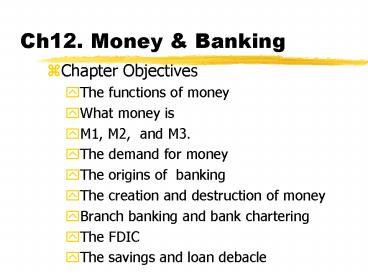Ch12' Money PowerPoint PPT Presentation
1 / 10
Title: Ch12' Money
1
Ch12. Money Banking
- Chapter Objectives
- The functions of money
- What money is
- M1, M2, and M3.
- The demand for money
- The origins of banking
- The creation and destruction of money
- Branch banking and bank chartering
- The FDIC
- The savings and loan debacle
2
Ch12. Money Banking
- The Four Jobs of Money
- medium of exchange
- standard of value
- store of value
- standard of deferred payment
- Money Supply
- Money consists of coins, paper money, demand
deposits, and checklike deposits. - M1, M2 and M3
3
Ch12. Money Banking
- Our money supply includes not just currency and
demand deposits but also travelers check and
what the Federal Reserve terms other checkable
deposits, - M1 currency, demand deposits, travelers checks,
and other checkable deposits. - M2 M1 savings, small-denomination time
deposits, and money market funds - M3 M2 large-denomination time deposits
- The Demand for Money
- Why people hold money?
- Keynes to make transactions, for precautionary
reasons, and to speculate
4
Ch12. Money Banking
- Four Influences on the Demand for Money
- (1) the price level (2) income (3)the interest
rate and (4) credit availability - As interest rates rise, people tend to hold less
money - As the rate of inflation rises, people tend to
hold more money - As the level of income rises, people tend to hold
more money - People tend to hold less money as credit
availability increases - The Demand Schedule for Money
- The transactions demand for money is somewhat
responsive to interest rate changes - The precautionary demand for money is least
responsive to interest rate changes because
people have a specific purpose for holding these
funds. - The speculative demand for money is the most
responsive to interest rate changes
5
Ch12. Money Banking
- Determination of the Interest Rate
- what is interest rate
- As the interest rate declines, the amount of
money that the public wished to hold goes up. - If we think of the interest as the price of
money, then the interest rate, like the price of
anything else, is set by the forces of supply and
demand. - The supply of money is controlled by the Federal
Reserve. - Who control interest rates? The Fed, the banks,
the people who borrow money. - Banking
- Bank Lending
- Borrow money at low interest rates and lend that
money out at much higher interest rates
6
Ch12. Money Banking
- Financial Intermediaries(banks)
- Financial Intermediaries channel funds from
savers to borrowers. Basically they repackage the
flow of deposits, insurance premiums, pension
contributions, and other forms of savings into
larger chunks for large business borrowers. - The Creation and Destruction of Money
- Banks create money by making loans. Money is
destroyed when a loan is repaid to the bank. - Limits to Deposit Creation
- Bankers would expand their loans only up to the
point at which they had just 2 percent cash
reserves. - Bank Regulation
- The three types of branch banking are
- Unrestricted branching(may open branches
throughout the state) - limited branching(may be allowed to open branches
only in contiguous communities) - Unit banking(state law forbids any branching
whatsoever)
7
Ch12. Money Banking
- State and Nationally Chartered Banks
- All nationally chartered banks must join the
Federal Reserve System. All Federal Reserve
member banks must join the FDIC. Only a small
percentage of the state-chartered banks are
members of the Federal Reserve. Nearly all banks
are members of the FDIC. - The FDIC(The Federal Deposit Insurance
Corporation) - The FDIC taxes its members from 0 to 27 cents for
every 100 of deposits in exchange for insuring
all member bank deposits of up to 100,000. - Will the FDIC run out of money? Not really. The
Congress, the Federal Reserve, the Treasury, and
all the financial resources of the U.S.
government are committed to the preservation of
this institution.
8
Ch13 The Federal Reserve Monetary Policy
- Chapter Objectives
- The organization of the Federal Reserve System
- Reserve requirements
- The deposit expansion multiplier
- The tools of monetary policy
- The Feds effectiveness in fighting inflation and
recession - The Banking Act of 1980
9
Ch13 The Federal Reserve Monetary Policy
- The Federal Reserve District Banks
- There are 12 Federal Reserve District Banks.
- All the paper currency issued by the Boston
Federal Reserve District Bank in the First
District has an A on the face of the bill about
an inch and a half from the left edge. Currency
issued by the Second Federal Reserve District
Bank in New York has a B, while the Philadelphia
Bank in the Third District has a C. - A commercial bank becomes a member by buying
stock in the Federal Reserve District Bank.
Effective control is really exercised by the
Federal Reserve Board of Governors in Washington,
D.C. - The Board of Governors
- The seven members of the Board of Governors are
nominated by the president, subject to
confirmation by the Senate. - Independence of the Board of Governors The Fed
is an independent agency.
10
Ch13 The Federal Reserve Monetary Policy
- Legal Reserve Requirements
- The feds most important job is to control the
money supply. - Actual reserves-required reserves excess
reserves - Treasury bills, notes, certificates, and bonds
are generally considered a banks secondary
reserves. - Deposit Expansion
- Deposit expansion mulitplier 1/reserve ratio
- Cash, checkes and electronic money
- The Tools of Monetary Policy
- FOMC
- Discount Rate Changes
- Changing Reserve requirements

